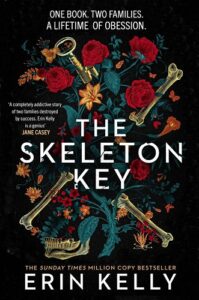The human urge to uncover hidden things is behind the enduring appetite for crime fiction, where we turn the pages to search for the truth. The impulse to solve clues and find buried treasure explains the success of everything from The Da Vinci Code to The Goonies, and hatched a sub-genre that sparks the kind of obsession you’d find in the pages of a psychological thriller. Literary treasure hunts, word-and-picture books containing clues to buried treasure, literal or figurative, inspired my latest suspense novel, THE SKELETON KEY.
In my fictional treasure hunt, a golden skeleton is scattered across England, the clues hidden in a storybook called The Golden Bones. What starts as a game soon turns deadly, and when the author’s daughter is subject to a stalker who can’t distinguish the girl from the character in the book, he calls off the search. But there remain hunters who have lost track of where reality ends and fantasy begins, and will stop at nothing to retrieve what they rightfully believe is theirs.
Real-life treasure hunts have led to divorce, death and attempted murder. Here are the four most celebrated – and controversial – literary hunts of them all.

Masquerade by Kit Williams
The original armchair treasure hunt is the 1979 global million-seller Masquerade, by Gloucestershire artist Kit Williams. In it, the moon tasks Jack Hare to deliver a jewel to the sun. Its intricate, fantastical paintings invite readers to stare at each page for minutes on end. When Jack Hare loses the jewel, it’s up to the readers to work out the location where Williams had hidden a real hand-beaten, jewel-studded golden hare. It was a phenomenon, obsessing some hunters to the extent that the book was cited in divorce proceedings. At one stage the author was receiving two mailbags a day from fans convinced they’d solved the hunt. Airlines sold transatlantic ‘Masquerade’ tickets; passengers were given a spade upon arrival in England. The solution? Lines traced from the eyes of figures (human or animal) through their hands, feet, hooves or paws, point to letters which revealed a master riddle. Solving that riddle led to a specific spot in Bedfordshire, England, under the shadow cast by a stone cross commemorating Katherine of Aragon. In 1982, two physics teachers solved the riddle but before they could claim the treasure, Kit Williams’ ex-girlfriend’s new boyfriend’s business partner (do keep up) had made an educated guess and claimed the treasure as his own. The bad faith find soured the hunt, and the artist became a virtual recluse.
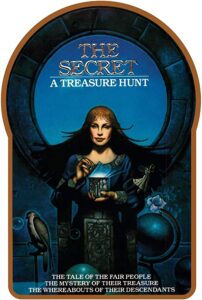
The Secret by Byron Preiss
You know a book has a devoted, even slavish following when their fansite is called Into The Abyss, and their Facebook group kicks off with a warning to hunters that it’s ok to take a break from the hunt if your mental health is suffering. Like Masquerade before it, The Secret features elaborate painted illustrations and draws on folklore. Three hundred years ago, the story goes, The Fair People – goblins, fairies dragons and other fabulous creatures – fled the Old World for the New, their pockets heavy with jewels. But then they – and their treasure vanished. Readers must study twelve paintings and twelve verses to claim the real-life ‘treasure casques’. Preiss died suddenly in 2005 without leaving a record of the casques’ locations. To date, only three have been found, and as land is constantly developed, there’s a good chance a number of them are now deep under a skyscraper or house, never to be retrieved. The impossibility of a solution only seems to add to the appeal.
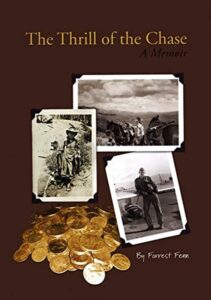
The Thrill of the Chase by Forrest Fenn
The tragic one: this treasure hunt has a real-life body count. It was also the first literary treasure hunt of the internet age. In 2010, antiquarian Forrest Fenn buried a million-dollar treasure chest rare artefacts in the Rocky Mountains. He hid the clues in a map and a poem at the end of his memoir, The Thrill of the Chase. It was controversial from the off, as hunters began to dig up swathes of national park. The terrain was more challenging than the gentle slopes of Bedfordshire, and least five men are known to have died while hunting, falling down crevices, losing control of rafts or simply from exposure. At the height of ‘Fenn Fever’ 350k people were said to be searching for the casque. Fenn’s home was broken into numerous times and he had to install the kind of security usually reserved for controversial politicians. Hunters who said their solves had been ‘hacked’ planned to sue. This was certainly true of the eventual finder, medical student Jack Stuef, who refuses to give up the solution. On the forums, the Fenn stans call him Stuef a fake and a cheat: he has gone into hiding, claiming that the negative attention has brought him close to a breakdown.
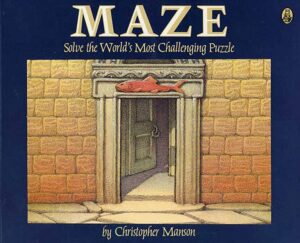
Maze by Christopher Manson
Maze has been called the world’s most difficult puzzle. It claims not to be a book, but a building in the shape of the book. If it is a building, it’s a claustrophobic nightmare of winding staircases and infinity paths as sketched by MC Escher. Each numbered page depicts a room in the maze. The doors in each room lead to other rooms. Moody, pen-and-ink sketches show rooms full of mysterious artefacts. The reader’s quest is to journey from Room 1 to room 45 in only sixteen steps but there are red herrings aplenty and it’s possible to spend days looping back on yourself. One of the unsolved puzzles is the identity of the unseen ‘guide’. People have theorised that it’s the Minotaur, Icarus, God, Satan, even… an umbrella. The author expected the $10,000 prize to be claimed well before the 1986 deadline, but the end date was extended twice before the publishers decided to split the prize money between the ten hunters who had got close but no cigar (or ten grand). A typical internet review? This book will be the death of me.
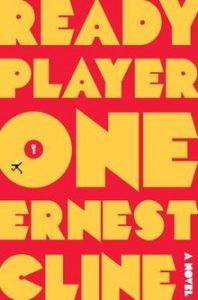
Ready Player One by Ernest Cline
A cult novel rather than a picture book, and one that didn’t actually become a treasure hunt until it was published in paperback, with an easter egg and a series of online gaming challenges with a DeLorean as the grand prize. Set in a dystopian 2044, young people shun the real world for the OASIS, a virtual reality comprising limitless worlds, competing to solve the hunt and become the owner of the OSASIS. RP1 straddles literature and the virtual world, where the clues require an obsessive knowledge of 1980s gaming, music and movie culture. It’s also a cautionary tale about toxic fandom and the dangers of losing yourself to a fantasy world… delusions which are central to the plot of The Skeleton Key!
***


